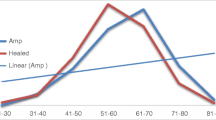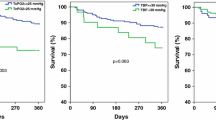Abstract
Diabetics develop foot ulcers due to peripheral ischaemia, neuropathy, or nero-ischaemia both. With rising prevalence of peripheral arterial occlusive disease (PAOD), it is considered the most important factor in development of foot ulcer and may subsequently lead to leg amputation among them. Various modalities available to assess the severity of vasculopathy among diabetic patients include measurement of Ankle Brachial Pressure Index (ABI), Toe Brachial Pressure Index (TBI), and Trans-cutaneous Partial pressure of Oxygen (TcPO2). Though, each modality, mentioned above, can predict the limb outcome (ulcer healing/ minor or major amputations) independently, but their predictive abilities are variable in various studies. This was a cross-sectional, observational study conducted over 100 patients with 108 diabetic feet, which has compared the accuracy of ABI, TBI, and TcPO2 in predicting limb outcome among patients with vasculopathy associated foot ulcers among diabetics. Patients who underwent major and minor amputations had mean ABI of 0.54 ± 0.22 and 0.85 ± 0.19, mean TBI of 0.25 ± 0.12 and 0.42 ± 0.26, and mean TcPO2 of 27.08 ± 11.88 and 41.29 ± 22.56 respectively. Out of three modalities, TcPO2 had the maximum predictive ability (AUC — 0.865009) for amputation followed by TBI (AUC — 0.825865). In patients with vaculopathy associated DFUs, TcPO2 is a better predictor of limb outcome when compared to TBI and ABI.

Similar content being viewed by others
References
Rose GA, Blackburn H, Gillum RF, Prineas RJ (1982) Cardiovascular survey methods. World Health Organization - Monograph Series. No. 56
Smith SR, Reed JF 3rd (2002) Prevalence of mixed infections in the diabetic pedal wound: a perspective based on a national audit. Int J Low Extrem Wounds 1(2):125–8. https://doi.org/10.1177/1534734602001002007
New JP, McDowell D, Burns E, Young RJ (1998) Problem of amputations in patients with newly diagnosed diabetes mellitus. Diabet Med 15:760–764
Edmonds ME (1987) Expenence in a multidisciplinary diabetic foot clinic. In: Connor H, Boulton AJM, Ward JD (eds) The foot in diabetes: proceedings of the first national conference on the diabetic foot. Malvem, England. May 1986, John Wiley, Chichester, England, pp 121–134
Ndip A, Jude EB (2009) Emerging evidence for neuroischemic diabetic foot ulcers: model of care and how to adapt practice. Int J Low Extrem Wounds 8(2):82–94
Gershater MA, Londahl M, Nyberg P, Larsson J, Thorne J, Eneroth M et al (2009) Complexity of factors related to outcome of neuropathic and neuroischaemic/ischaemic diabetic foot ulcers: a cohort study. Diabetologia 52(3):398–407
Prompers L, Schaper N, Apelqvist J, Edmonds M, Jude E, Mauricio D et al (2008) Prediction of outcome in individuals with diabetic foot ulcers: focus on the differences between individuals with and without peripheral arterial disease. The EURODIALE Study Diabetologia 51(5):747–755
Karunakaran K, Sathyapriya B, Rajkiran T, Anandan H (2016) Efficacy of diagnosing vascular occlusion in diabetic foot patients to improve the outcome. Int J Sci Stud 4(6):19–22
Elhadd T, Robb R, Jung R, Stonebridge P, Belch J (1999) Pilot study of prevalence of asymptomatic peripheral arterial occlusive disease in patients with diabetes attending a hospital clinic. Pract Diabetes Int 16:163–166
Wang Z, Hasan R, Firwana B, Elraiyah T, Tsapas A, Prokop L et al (2016) A systematic review and meta-analysis of tests to predict wound healing in diabetic foot. J Vasc Surg 63:29S-36S
Kalani M, Brismar K, Fagrell B, Ostergren J, Jörneskog G (1999) Transcutaneous oxygen tension and toe blood pressure as predictors for outcome of diabetic foot ulcers. Diabetes Care 22(1):147–151
Zhang P, Lu J, Jing Y, Tang S, Zhu D, Bi Y (2017) Global epidemiology of diabetic foot ulceration: a systematic review and meta-analysis. Ann Med 49(2):106–116
Saleem S, Hayat N, Ahmed I, Ahmed T, Rehan AG (2017) Risk factors associated with poor outcome in diabetic foot ulcer patients. Turk J Med Sci 47:826–831
Pendsey SP et al (1994) Epidemiological aspects of diabetic foot. Int J Diabetes 14:37–38
Al-Rubeaan K, Al Derwish M, Ouizi S, Ouizi S, Youssef AM, Subhani SN et al (2015) Diabetic foot complications and their risk factors from a large retrospective cohort study. PLoS One 10(5):e0124446
Zhou ZY, Liu YK, Chen HL, Yang HL, Liu F (2015) HbA1c and lower extremity amputation risk in patient with diabetes: a meta-analysis. Int J Low Extrem Wounds 14(2):168–177
Fife CE, Smart DR, Sheffield PJ, Hopf HW, Hawkins G, Clarke D (2009) Transcutaneous oximetry in clinical practice: consensus statements from an expert panel based on evidence. Undersea & Hyperb Med 36(1):43–53
Author information
Authors and Affiliations
Contributions
(a) Conceptualization: Dr Vembu Anand, Dr Amit kumar Singh, and Dr Rakesh Kumar Jha.
(b) Design: Dr Amit Kumar Singh, Dr Rakesh Kumar Jha, and Dr Amit Pushkarna.
(c) Definition of intellectual content: Dr Amit Kumar Singh, Dr Vembu Anand, Dr Rakesh Kumar Jha, and Dr Amit Pushkarna.
(d) Literature search: Dr Rakesh Kumar Jha, Dr Amit Kumar Singh, and Dr Amit Pushkarna.
(e) Clinical studies: Dr Vembu Anand, Dr Amit Kumar Singh, Dr Amit Pushkarna, and Dr Rakesh Jha.
(f) Experimental studies: Dr Rakesh Kumar Jha, Dr Amit Kumar Singh, and Dr Vembu Anand.
(g) Data acquisition, data analysis and statistical analysis: Dr Rakesh Kumar Jha, Dr Amit Kumar Singh, and Dr Amit Pushkarna.
(h) Manuscript preparation: Dr Rakesh Kumar Jha and Dr Amit Kumar Singh.
(i) Manuscript editing and manuscript review: Dr Vembu Anand and Dr Amit Pushkarna.
Corresponding author
Ethics declarations
Ethical Approval
The research was performed after taking approval from Institutional Ethical and Research Committee and obtaining written informed consent from patients’ prior enrolment.
Conflict of Interest
The authors declare no competing interests.
Additional information
Publisher's Note
Springer Nature remains neutral with regard to jurisdictional claims in published maps and institutional affiliations.
Rights and permissions
Springer Nature or its licensor (e.g. a society or other partner) holds exclusive rights to this article under a publishing agreement with the author(s) or other rightsholder(s); author self-archiving of the accepted manuscript version of this article is solely governed by the terms of such publishing agreement and applicable law.
About this article
Cite this article
Anand, V., Singh, A.K., Pushkarna, A. et al. Comparison of Ankle Brachial Index (ABI), Toe Brachial Index (TBI), and Trans-Cutaneous Partial Pressure of Oxygen (TcPO2) in Prediction of Limb Outcome Among Patients with Diabetic Foot Ulcers (DFUs). Indian J Surg (2023). https://doi.org/10.1007/s12262-023-03933-7
Received:
Accepted:
Published:
DOI: https://doi.org/10.1007/s12262-023-03933-7




